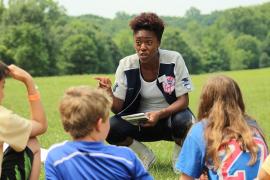Creating equitable hiring practices has been a hot topic lately, and there are various ways to achieve this goal.
Many organizations and camps want to increase diversity and representation in their staff, but often see high turnover and little retention. Hiring and recruitment constantly evolve, so we need a transformative approach focused on human-centered hiring. Human-centered hiring shifts the focus from the organization’s needs but instead considers both the candidate's and employers’ needs. It's not only about filling positions but also about building long-lasting relationships, understanding the needs of the candidates, and creating a sense of belonging. This approach goes beyond the traditional recruitment mindset, focusing on what candidates can offer the organization rather than merely filling gaps.
Human-centered hiring is not just limited to external recruitment but is also deeply connected with internal work, organizational culture, and the pursuit of diversity, equity, and inclusion (DEI). In this blog, we will explore the fundamental concepts of human-centered hiring, emphasizing the significance of developing trust, nurturing a sense of belonging, and advocating equity in the hiring process.
Internal and External Work: The Foundation of Transformation
Understanding the two sides of transformational work, internal and external, is crucial before delving into the intricacies of human-centered hiring. Internally, it involves promoting a culture of learning and improving staff cohesion. Externally, the focus shifts to how organizations interact with the community outside — through hiring, recruitment, access to training, community events, and stewardship.
Building Trust, Belonging, and Equity in the Hiring Process
The journey toward fostering a diverse and inclusive organization begins with acknowledging the stages of belonging. It's a climb marked by awareness, embracing diversity, fostering connection, advancing towards justice, and finally, empowerment — a transformed organization.
External efforts must align with this journey. If the goal is to increase diversity and representation in the hiring process, the transformation must start both internally and externally within the organization. To achieve this, it's important to focus on building trust, belonging, and equity in the hiring process.
Best Practices: Nurturing a Human-Centered Hiring Approach
Communication Best Practices
Transparent communication is the bedrock of human-centered hiring. Sharing the hiring timeline in the job description sets the stage for a collaborative and open process. Keeping candidates informed at every stage — reviewing applications, making decisions, and potential changes in the timeline — builds trust. Consider communicating things like:
- What steps are involved in the hiring process?
- When do you plan to reach out?
- When will you be reviewing applications?
- When do you plan to make a decision?
Transparency and communication build trust. Building trust from the beginning sets the organization up for success. It encourages applicants to apply again for future seasons (even if they were not the right fit this time around).
Job Application Best Practices
The application process is the point at which candidates decide if they should invest their time in applying to your organization. By offering multiple submission formats, such as video or text, you can cater to diverse candidate preferences. Instead of asking for a traditional cover letter, you can pose specific questions that prompt candidates to share meaningful examples that showcase their skills and experiences. Consider exactly what you want to know about the candidates — if you are looking for interpersonal skills, a video response may be better than a cover letter.
Interviewing Best Practices
Mastering the art of conducting interviews that reveal a candidate's true potential is essential. To achieve this, it is vital to outline the skills you want to learn about the candidates and utilize them as your rubric. This shift in focus from right or wrong answers to a more comprehensive evaluation will help you conduct a more effective interview. Here are some things to consider:
- Embrace diversity in responses: Recognize that there's more than one way to answer a question. Create an evaluation rubric that evaluates skills rather than answers. This allows candidates to respond in various ways, with multiple examples to showcase a skill. For example, choose 3–5 skills that you would like to see demonstrated throughout the interview. The Hanover Research Group provides an excellent guide on how to write interview questions and evaluations.
- Shift interview questions from asking about past experiences to asking about present responses: Instead of the conventional "tell me about a time" questions, opt for situational prompts. For example, pose scenarios like "What would you do if . . . " or "How would you respond to . . . " to evaluate the same skills more equitably. Questions that ask the interviewee to remember or recall scenarios on the spot can screen out great candidates who have difficulties remembering specific situations. These questions also help level the playing field for folks who may not have the exact experience or situation you are asking about but can use their transferable skills to respond to a situation.
- Share the interview questions! Share interview questions ahead of time. This fosters transparency, relieves anxiety, and allows candidates to prepare. If you still would like to assess how folks think on their feet, ask them to prepare an activity or demonstrate a skill that aligns with the position. Asking potential counselors to lead an icebreaker at the beginning is a great way to see both how they prepare and react on the spot!
Conclusion: A Call to Action
So, where do you go from here? Start by mapping out the candidate’s journey. To improve trust, equity, and belonging in the application process, begin to look at your application process from the candidate's perspective. Identify the issues blocking these factors at each stage of the application process. Seek feedback from past and current applicants to gain insight into their experiences. Work collaboratively to identify opportunities for improvement and commit to making at least one change.
As we map out the candidate journey — discovery, application, interviewing, onboarding — it becomes clear that every interaction matters. Communication must be transparent, job applications inclusive, and interviews structured for fairness.
In conclusion, the power of human-centered hiring lies not only in its ability to attract diverse talent but in its capacity to shape organizational culture. By building trust, belonging, and equity, organizations can commit to creating transformation, both internally and externally. Together, we can take these transformative steps towards a more inclusive and equitable future.
This blog was written on behalf of Project Real Job whose purpose is to support camps in their efforts to recruit, hire, and retain staff.
Jordan Marino, of DEI Outdoors, has a background in conservation education and nonprofit management. Through their master's degree, Jordan has researched equity and justice issues within conservation careers, identifying best practices and solutions to making careers more accessible. Jordan currently provides support and guidance for outdoor educators, camps, and recreation orgs alike on how they can improve their staffing practice to create accessible opportunities for everyone. Jordan can be reached at jordan@deioutdoors.com.
Photo courtesy of Camp Chinqueka in Bantam, CT

